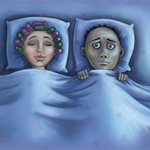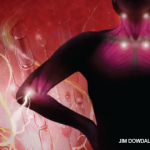BOSTON—Most American adults don’t get enough sleep. According to the National Institutes of Health, an estimated 30% of adults report some kind of sleep disturbance. Ten percent have chronic insomnia—and with it, pain, fatigue, mood swings, or memory problems. Sleep may be especially elusive for those with rheumatic disease. As many as 80% of these patients have sleeping problems, and half suffer from chronic insomnia.
In the last few years, many people with sleep disturbances have turned to new prescription drugs to fix the problem. (Ambien, which accounts for about 60% of all sleeping-pill prescriptions in the U.S., accounted for $2.8 billion in sales last year, according to IMS Health.) But these pills often come with side effects including dizziness, nausea, and—most commonly—feelings of “drugged drowsiness” during the day.
Cognitive behavioral therapies (CBTs)—in which patients modify their day- and nighttime habits in order to restore normal sleeping patterns—have been shown to be useful alternatives to pharmacological treatments. “Virtually all insomnias have a learned component,” says Pamela Degotardi, PhD, a developmental psychologist at Queens College in New York City. “CBT teaches strategies to change these learned behaviors.” Dr. Degotardi joined clinical psychologist Diana G. Fox, PsyD, also of Queens College, to lead the session titled “Improving Sleep: Non-Pharmacological Strategies” at the ACR/ARHP Annual Scientific Meeting in Boston last November.
The consequences of chronic insomnia can be debilitating. In one 2005 study, Dr. Fox points out, patients with chronic insomnia had problems performing tasks that measured vigilance, working memory, and motor control. Moreover, they self-reported negative moods and difficulty concentrating. A meta-analysis of studies that used subjects who were sleeping less than five hours a night on a regular basis found that these people had decreased glucose tolerance, increased blood pressure, reduced levels of leptin (an appetite-reducing hormone), and increased inflammatory markers. For those subjects who had poor sleeping patterns for six years or more, the study found a 15% increase in all-cause mortality—even after they had controlled for other risk factors like blood pressure and body mass index.
Identify Causes of Sleeplessness
Rather than focusing on the unfortunate consequences of chronic sleeping problems, the two experts stress treatment strategies. “The first step is assessing what exactly the sleeping problem is,” says Dr. Degotardi. The most effective way to do so, she adds, is with a thorough clinical interview. Doctors should ask these patients about their daily routine and typical sleep schedule—when they get to bed, when they wake up, how many naps they take, and whether any of this shifts dramatically on the weekends. They should ask how long it typically takes to fall asleep, if patients have frequent awakenings during the night, and if they can fall back to sleep after these disturbances.
“You should also ask questions about sleep quality,” says Dr. Degotardi. “Not just how much sleep they get, but how do they feel when they get up. Refreshed? Or groggy and lethargic and dragging themselves through the day?”
Doctors can also ask their patients’ partners for crucial information. Do they notice any snoring, choking, or gasping during the night? Twitching arms and legs might also be a sign of sleep apnea.
Occupational factors, too, are very important. Working during the late shift, for instance, “is really hard to cope with,” says Dr. Degotardi. Those who travel frequently between time zones or have lengthy commutes might also be at risk for disturbed sleep. “You spend a lot of time in the car, and then don’t go straight to bed when you get home,” she says.
Though some factors are beyond patients’ control, many sleeping problems are a result of lifestyle choices—something Dr. Degotardi terms volitional chronic sleep deprivation. “There’s so much to do in our lives: Get the kids’ lunches made, check the bus [driver’s] report, pay the bills. We tend to treat sleep as the time that we can really cut back on. You figure you’ll just go to bed later.”
Sometimes patients don’t realize how little sleep they’re getting. In these cases, it’s better to ask questions about specific symptoms. “One of the areas that’s really, really easy to pick up on is, are they falling asleep easily watching TV at night? Reading a book? Sitting in a hot room? All of these are signs of sleep deprivation,” says Dr. Degotardi. Finally, it’s important to ask patients about treatment strategies they may have already tried—like medication or yoga—so that you don’t recommend more of the same.
Document Patterns—Then Change Them
After a thorough interview, the next step is for patients to start keeping a sleep diary to record not only when they sleep, but how they’re feeling before and after. It’s especially useful at the beginning of treatment, as a baseline measure of problem areas on which to improve. “It really helps when talking about changes they might make,” explains Dr. Degotardi, “because you can track associations between behaviors they’re engaging in.”
Simple behavior changes start with making the bedroom comfortable, including having a good mattress, an optimal noise level, cool room temperature, and complete darkness. Before bed, light from a computer or a television can trigger the body to stay awake. If a person has to get up to use the bathroom in the middle of the night, the experts say it’s best not to turn on any lights. It’s also critical to form associative bonds between bed and sleep. “The feel and smell and sight of your bed should be cues for falling sleep, not for frustration and wakefulness,” says Dr. Degotardi. Even simply turning around the alarm clock to keep the digital readout from distracting you could help.
Next, patients must learn to sleep on a normal schedule. “People who have problems sleeping think if they go to bed early that will help,” says Dr. Degotardi, “but you can’t force sleep.” One strategy, explains Dr. Fox, is called sleep restriction. If a patient has to get up at 6 a.m., for instance, and typically only gets four hours of sleep a night, then it’s best to tell her not to get into bed until 2 a.m. After a week or two, this time can be gradually moved up, until she’s getting drowsy at a much earlier hour and sleeping for much longer stretches of time. “And I do mean gradually!” said Dr. Fox. “You might only make it earlier in half-hour increments.”
But, do these seemingly simple CBT strategies actually work? “The answer is a resounding yes,” says Dr. Degotardi. A meta-analysis of 21 studies showed that about 75% of people improved after going through CBT. “The good news is that there are no side effects like with medications,” she adds. “And even better, it seems the improvements continue long after treatment starts.”
Finally, doctors should try to reduce their patients’ psychological worries about getting enough rest. Patients tend to worry that “tomorrow’s going to be a disaster, that it’s the end of the world, if I don’t get sleep tonight,” explains Dr. Fox. Those with other health conditions, in particular, believe that their future health is entirely dependent on how much sleep they get in one night. “That’s just a lot of pressure,” she says, and the anxiety usually makes it even more difficult to fall asleep.
“You’re not aiming for perfection—that’s the key,” says Dr. Degotardi. “No person has perfect sleep all the time. When you’re talking with patients, you’re educating them to be realistic about what their goals might be.”
Virginia Hughes is a medical writer based in New York City.



